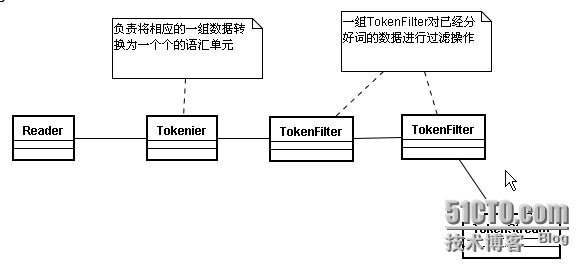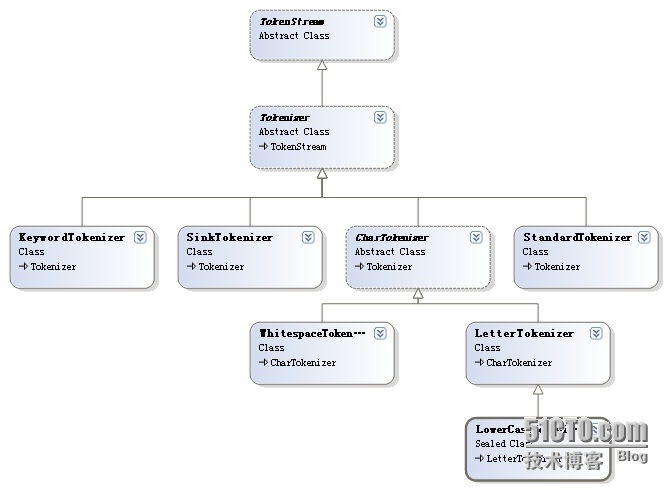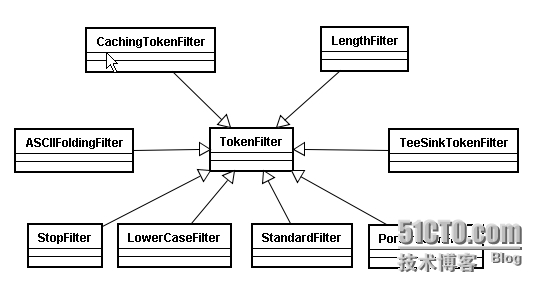首页 > 代码库 > 第四章 分词
第四章 分词
4.1 分词器的核心类
1. Analyzer
Lucene内置分词器SimpleAnalyzer、StopAnalyzer、WhitespaceAnalyzer、StandardAnalyzer
主要作用:
KeywordAnalyzer分词,没有任何变化;
SimpleAnalyzer对中文效果太差;
StandardAnalyzer对中文单字拆分;
StopAnalyzer和SimpleAnalyzer差不多;
WhitespaceAnalyzer只按空格划分。
2. TokenStream
分词器做好处理之后得到的一个流,这个流中存储了分词的各种信息,可以通过TokenStream有效的获取到分词单元信息
生成的流程

在这个流中所需要存储的数据

3. Tokenizer
主要负责接收字符流Reader,将Reader进行分词操作。有如下一些实现类

4. TokenFilter
将分词的语汇单元,进行各种各样过滤

5.扩展:TokenFilter各类介绍:
(1),TokenFilter
输入参数为另一个TokerStream的TokerStream,其子类必须覆盖incrementToken()函数。
(2),LowerCaseFilter
将Token分词转换为小写。
(3),FilteringTokenFilter
TokenFilters的一个抽象类,可能会删除分词。如果当前分词要保存,则需要实现accept()方法
并返回一个boolean值。incrementToken()方法将调用accept()方法来决定是否将当前的分词返回
给调用者。
(4),StopFilter
从token stream中移除停止词(stop words).
protected boolean accept() {
return!stopWords.contains(termAtt.buffer(), 0, termAtt.length());//返回不是stop word的分词
}(5),TypeTokenFilter
从token stream中移除指定类型的分词。
protected boolean accept() {
returnuseWhiteList == stopTypes.contains(typeAttribute.type());
}(6),LetterTokenizer
是一个编译器,将文本在非字母。说,它定义了令牌的最大字符串相邻的字母
(7),TokenFilter的顺序问题
此时停止词 the 就未被去除了。先全部转换为小写字母,再过滤停止词(The 转换成 the 才可以与停止词词组里的 the 匹配),如果不限制大小写,停止词的组合就太多了。
import java.io.Reader;
import java.util.Set;
import org.apache.lucene.analysis.Analyzer;
importorg.apache.lucene.analysis.LetterTokenizer;
importorg.apache.lucene.analysis.LowerCaseFilter;
import org.apache.lucene.analysis.StopAnalyzer;
import org.apache.lucene.analysis.StopFilter;
import org.apache.lucene.analysis.TokenStream;
import org.apache.lucene.util.Version;
public class MyStopAnalyzer extends Analyzer {
privateSet<Object> words;
publicMyStopAnalyzer(){}
publicMyStopAnalyzer(String[] words ){
this.words=StopFilter.makeStopSet(Version.LUCENE_35,words, true);
this.words.addAll(StopAnalyzer.ENGLISH_STOP_WORDS_SET)
}
@Override
publicTokenStream tokenStream(String fieldName, Reader reader) {
// TODO Auto-generatedmethod stub
return newStopFilter(Version.LUCENE_35,new LowerCaseFilter(Version.LUCENE_35, newLetterTokenizer(Version.LUCENE_35,reader)),this.words);
}
}4.2Attribute
public static void displayAllTokenInfo(Stringstr,Analyzer a) {
try{
TokenStreamstream = a.tokenStream("content",new StringReader(str));
//位置增量的属性,存储语汇单元之间的距离
PositionIncrementAttributepia =
stream.addAttribute(PositionIncrementAttribute.class);
//每个语汇单元的位置偏移量
OffsetAttributeoa =
stream.addAttribute(OffsetAttribute.class);
//存储每一个语汇单元的信息(分词单元信息)
CharTermAttributecta =
stream.addAttribute(CharTermAttribute.class);
//使用的分词器的类型信息
TypeAttributeta =
stream.addAttribute(TypeAttribute.class);
for(;stream.incrementToken();){
System.out.print(pia.getPositionIncrement()+":");
System.out.print(cta+"["+oa.startOffset()+"-"+oa.endOffset()+"]-->"+ta.type()+"\n");
}
}catch (Exception e) {
e.printStackTrace();
}
}4.3 自定义分词器
1.自定义Stop分词器
package com.mzsx.analyzer;
import java.io.Reader;
import java.util.Set;
import org.apache.lucene.analysis.Analyzer;
importorg.apache.lucene.analysis.LetterTokenizer;
importorg.apache.lucene.analysis.LowerCaseFilter;
import org.apache.lucene.analysis.StopAnalyzer;
import org.apache.lucene.analysis.StopFilter;
import org.apache.lucene.analysis.TokenStream;
import org.apache.lucene.util.Version;
public class MyStopAnalyzer extends Analyzer {
privateSet<Object> words;
publicMyStopAnalyzer(){}
publicMyStopAnalyzer(String[] words ){
this.words=StopFilter.makeStopSet(Version.LUCENE_35,words, true);
this.words.addAll(StopAnalyzer.ENGLISH_STOP_WORDS_SET);
}
@Override
publicTokenStream tokenStream(String fieldName, Reader reader) {
returnnew StopFilter(Version.LUCENE_35,new LowerCaseFilter(Version.LUCENE_35, newLetterTokenizer(Version.LUCENE_35,reader)),this.words);
}
}//测试代码
@Test
publicvoid myStopAnalyzer() {
Analyzera1 = new MyStopAnalyzer(new String[]{"I","you","hate"});
Analyzera2 = new MyStopAnalyzer();
Stringtxt = "how are you thank you I hate you";
AnalyzerUtils.displayAllTokenInfo(txt,a1);
//AnalyzerUtils.displayToken(txt,a2);
}
2.简单实现同义词索引
package com.mzsx.analyzer;
public interface SamewordContext {
publicString[] getSamewords(String name);
}package com.mzsx.analyzer;
import java.util.HashMap;
import java.util.Map;
public class SimpleSamewordContext implementsSamewordContext {
Map<String,String[]>maps = new HashMap<String,String[]>();
publicSimpleSamewordContext() {
maps.put("中国",new String[]{"天朝","大陆"});
maps.put("我",new String[]{"咱","俺"});
maps.put("china",new String[]{"chinese"});
}
@Override
publicString[] getSamewords(String name) {
returnmaps.get(name);
}
}package com.mzsx.analyzer;
import java.io.IOException;
import java.util.Stack;
import org.apache.lucene.analysis.TokenFilter;
import org.apache.lucene.analysis.TokenStream;
importorg.apache.lucene.analysis.tokenattributes.CharTermAttribute;
importorg.apache.lucene.analysis.tokenattributes.PositionIncrementAttribute;
import org.apache.lucene.util.AttributeSource;
public class MySameTokenFilter extendsTokenFilter {
privateCharTermAttribute cta = null;
privatePositionIncrementAttribute pia = null;
privateAttributeSource.State current;
privateStack<String> sames = null;
privateSamewordContext samewordContext;
protectedMySameTokenFilter(TokenStream input,SamewordContext samewordContext) {
super(input);
cta= this.addAttribute(CharTermAttribute.class);
pia= this.addAttribute(PositionIncrementAttribute.class);
sames= new Stack<String>();
this.samewordContext= samewordContext;
}
@Override
publicboolean incrementToken() throws IOException {
if(sames.size()>0){
//将元素出栈,并且获取这个同义词
Stringstr = sames.pop();
//还原状态
restoreState(current);
cta.setEmpty();
cta.append(str);
//设置位置0
pia.setPositionIncrement(0);
returntrue;
}
if(!this.input.incrementToken())return false;
if(addSames(cta.toString())){
//如果有同义词将当前状态先保存
current= captureState();
}
returntrue;
}
privateboolean addSames(String name) {
String[]sws = samewordContext.getSamewords(name);
if(sws!=null){
for(Stringstr:sws) {
sames.push(str);
}
returntrue;
}
returnfalse;
}
}package com.mzsx.analyzer;
import java.io.Reader;
import org.apache.lucene.analysis.Analyzer;
import org.apache.lucene.analysis.TokenStream;
import com.chenlb.mmseg4j.Dictionary;
import com.chenlb.mmseg4j.MaxWordSeg;
importcom.chenlb.mmseg4j.analysis.MMSegTokenizer;
public class MySameAnalyzer extends Analyzer {
privateSamewordContext samewordContext;
publicMySameAnalyzer(SamewordContext swc) {
samewordContext= swc;
}
@Override
publicTokenStream tokenStream(String fieldName, Reader reader) {
Dictionarydic = Dictionary.getInstance("D:/luceneIndex/dic");
returnnew MySameTokenFilter(
newMMSegTokenizer(new MaxWordSeg(dic), reader),samewordContext);
}
}//测试代码
@Test
publicvoid testSameAnalyzer() {
try{
Analyzera2 = new MySameAnalyzer(new SimpleSamewordContext());
Stringtxt = "我来自中国海南儋州第一中学,welcome to china !";
Directorydir = new RAMDirectory();
IndexWriterwriter = new IndexWriter(dir,new IndexWriterConfig(Version.LUCENE_35, a2));
Documentdoc = new Document();
doc.add(newField("content",txt,Field.Store.YES,Field.Index.ANALYZED));
writer.addDocument(doc);
writer.close();
IndexSearchersearcher = new IndexSearcher(IndexReader.open(dir));
TopDocstds = searcher.search(new TermQuery(new Term("content","咱")),10);
Documentd = searcher.doc(tds.scoreDocs[0].doc);
System.out.println("原文:"+d.get("content"));
AnalyzerUtils.displayAllTokenInfo(txt,a2);
}catch (CorruptIndexException e) {
e.printStackTrace();
}catch (LockObtainFailedException e) {
e.printStackTrace();
}catch (IOException e) {
e.printStackTrace();
}
}本文出自 “梦朝思夕” 博客,请务必保留此出处http://qiangmzsx.blog.51cto.com/2052549/1549902
第四章 分词
